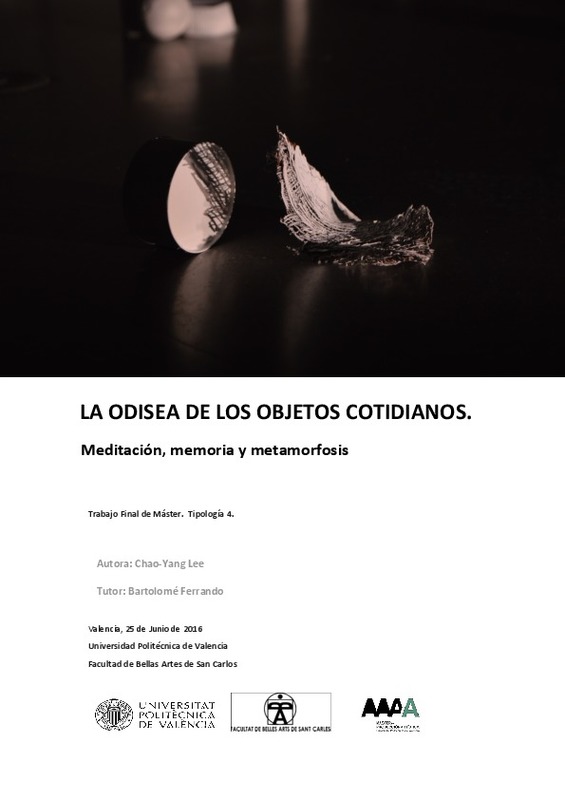JavaScript is disabled for your browser. Some features of this site may not work without it.
Buscar en RiuNet
Listar
Mi cuenta
Estadísticas
Ayuda RiuNet
Admin. UPV
LA ODISEA DE LOS OBJETOS COTIDIANOS. MEDITACIÓN, MEMORIA Y METAMORFOSIS
Mostrar el registro sencillo del ítem
Ficheros en el ítem
| dc.contributor.advisor | Ferrando Colom, Bartolomé
|
es_ES |
| dc.contributor.author | LEE, CHAO-YANG
|
es_ES |
| dc.date.accessioned | 2016-07-29T09:10:09Z | |
| dc.date.available | 2016-07-29T09:10:09Z | |
| dc.date.created | 2016-07-07 | |
| dc.date.issued | 2016-07-29 | es_ES |
| dc.identifier.uri | http://hdl.handle.net/10251/68431 | |
| dc.description.abstract | [EN] The final project of the master’s degree (TFM) is about the daily life objects and their trajectories with the art practice; meanwhile, it intends to offer an alternative way of looking at the daily life objects that inspire us toward the art. Moreover, it considers that the investigation of the project is journey that contains the search and the encounter, the same as the process of artistic creation. In the theoretical part, it focuses on the origin of ready-made and its evolution in the history of art. It also talked about its relativity to the insignificant in our daily life as the practice of arts. During the fifties, the interaction between the East and the West, a few artists began to take interest in the idea of Zen and pay attention to the daily life objects. The creation of arts became a process of meditation on their environments. Regarding these issues, it would also talk about some related artists. As for the second part, the analysis of the works created during the period of the investigation was carried out, and it also discussed how the ideas began, developed, processed and evolved. We recognize that the works of arts not only serve as a means of expression for the artist, but also establish an alternative way of seeing for the viewers. | es_ES |
| dc.description.abstract | [ES] El TFM se divide fundamentalmente en dos partes, la primera incluye las bases teóricas, argumentos y análisis de la investigación, mientras que la segunda es la descripción y análisis de las obras realizadas. Para concluir el TFM, se sugiere que después de que Marcel Duchamp creó el llamado ready-made, los objetos cotidianos se han utilizado como medio para transmitir los pensamientos de los artistas. Por otra parte, la meditación en los objetos cotidianos se permite llevar a los espectadores más allá del mundo interior del artista. | es_ES |
| dc.format.extent | 90 | es_ES |
| dc.language | Español | es_ES |
| dc.publisher | Universitat Politècnica de València | es_ES |
| dc.rights | Reserva de todos los derechos | es_ES |
| dc.subject | Objeto cotidiano | es_ES |
| dc.subject | Ready-made | es_ES |
| dc.subject | Meditación | es_ES |
| dc.subject | Memoria | es_ES |
| dc.subject | Metamorfosis | es_ES |
| dc.subject | Lo insignificante | es_ES |
| dc.subject.classification | ESCULTURA | es_ES |
| dc.subject.classification | PINTURA | es_ES |
| dc.subject.other | Máster Universitario en Producción Artística-Màster Universitari en Producció Artística | es_ES |
| dc.title | LA ODISEA DE LOS OBJETOS COTIDIANOS. MEDITACIÓN, MEMORIA Y METAMORFOSIS | es_ES |
| dc.type | Tesis de máster | es_ES |
| dc.rights.accessRights | Abierto | es_ES |
| dc.description.bibliographicCitation | Lee, C. (2016). LA ODISEA DE LOS OBJETOS COTIDIANOS. MEDITACIÓN, MEMORIA Y METAMORFOSIS. http://hdl.handle.net/10251/68431. | es_ES |
| dc.description.accrualMethod | TFGM | es_ES |
| dc.relation.pasarela | TFGM\50978 | es_ES |
Este ítem aparece en la(s) siguiente(s) colección(ones)
-
BBAA - Trabajos académicos [5086]
Facultad de Bellas Artes






